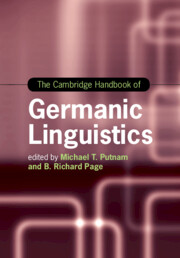Book contents
- The Cambridge Handbook of Germanic Linguistics
- Cambridge Handbooks in Language and Linguistics
- The Cambridge Handbook of Germanic Linguistics
- Copyright page
- Contents
- Figures
- Maps
- Tables
- Contributors
- Acknowledgments
- Germanic Languages
- Part I Phonology
- Chapter 1 Phonological Processes in Germanic Languages
- Chapter 2 Germanic Syllable Structure
- Chapter 3 The Role of Foot Structure in Germanic
- Chapter 4 Word Stress in Germanic
- Chapter 5 Quantity in Germanic Languages
- Chapter 6 Germanic Laryngeal Phonetics and Phonology
- Chapter 7 Tone Accent in North and West Germanic
- Chapter 8 Intonation in Germanic
- Part II Morphology and Agreement Systems
- Part III Syntax
- Part IV Semantics and Pragmatics
- Part V Language Contact and Nonstandard Varieties
- Index
- References
Chapter 3 - The Role of Foot Structure in Germanic
from Part I - Phonology
Published online by Cambridge University Press: 31 March 2020
- The Cambridge Handbook of Germanic Linguistics
- Cambridge Handbooks in Language and Linguistics
- The Cambridge Handbook of Germanic Linguistics
- Copyright page
- Contents
- Figures
- Maps
- Tables
- Contributors
- Acknowledgments
- Germanic Languages
- Part I Phonology
- Chapter 1 Phonological Processes in Germanic Languages
- Chapter 2 Germanic Syllable Structure
- Chapter 3 The Role of Foot Structure in Germanic
- Chapter 4 Word Stress in Germanic
- Chapter 5 Quantity in Germanic Languages
- Chapter 6 Germanic Laryngeal Phonetics and Phonology
- Chapter 7 Tone Accent in North and West Germanic
- Chapter 8 Intonation in Germanic
- Part II Morphology and Agreement Systems
- Part III Syntax
- Part IV Semantics and Pragmatics
- Part V Language Contact and Nonstandard Varieties
- Index
- References
Summary
This chapter demonstrates the varied role the foot has played in shaping phonological and morphophonological patterns across the Germanic languages. Data from German and Dutch dialects highlight how features are licensed differently in strong versus weak branches of feet paving the way for a range of patterns including medial consonant cluster simplification and consonant lenition which often result in worsened phonetic cues. The trochee is shown to shape morphological processes such as Dutch and German plural formation via prosodic templates in both the standard languages and dialects. Lastly, vowel balance in Frisian and Scandinavian, a process often argued to result from stress patterns and stem shapes, is reinterpreted in terms of the trochaic foot. The foot-based approach provides a unified account for various manifestations of vowel balance across the dialects. Scratching the surface of Germanic phenomena, the chapter serves to invite the reader to consider other patterns which may also be prosodically driven in terms of the foot and foot-based templates.
Keywords
- Type
- Chapter
- Information
- The Cambridge Handbook of Germanic Linguistics , pp. 49 - 72Publisher: Cambridge University PressPrint publication year: 2020
References
- 2
- Cited by



